
Apulia, also known by its Italian name Puglia, is a region of Italy, located in the southern peninsular section of the country, bordering the Adriatic Sea to the east, the Ionian Sea to the southeast and the Strait of Otranto and Gulf of Taranto to the south. The region comprises 19,345 square kilometers (7,469 sq mi), and its population is about four million people.

Brindisi is a city in the region of Apulia in southern Italy, the capital of the province of Brindisi, on the coast of the Adriatic Sea. Historically, the city has played an important role in trade and culture, due to its strategic position on the Italian Peninsula and its natural port on the Adriatic Sea. The city remains a major port for trade with Greece and the Middle East. Its industries include agriculture, chemical works, and the generation of electricity.

Salento is a cultural, historical and geographic region at the southern end of the administrative region of Apulia in Southern Italy. It is a sub-peninsula of the Italian Peninsula, sometimes described as the "heel" of the Italian "boot". It encompasses the entire administrative area of the province of Lecce, a large part of the province of Brindisi and part of that of Taranto.

The Province of Brindisi is a province in the Apulia region of Italy. Its capital is the city of Brindisi. It has an area of 1,839 square kilometres (710 sq mi) and a total population of 401,652 (2013).

Negroamaro is a red wine grape variety native to southern Italy. It is grown almost exclusively in Apulia and particularly in Salento, the peninsula which can be visualised as the "heel" of Italy. The grape can produce wines very deep in color. Wines made from Negroamaro tend to be very rustic in character, combining perfume with an earthy bitterness. The grape produces some of the best red wines of Apulia, particularly when blended with the highly scented Malvasia Nera, as in the case of Salice Salentino.

The Messapians were an Iapygian tribe who inhabited Salento in classical antiquity. Two other Iapygian tribes, the Peucetians and the Daunians, inhabited central and northern Apulia respectively. All three tribes spoke the Messapian language, but had developed separate archaeological cultures by the seventh century BC. The Messapians lived in the eponymous region Messapia, which extended from Leuca in the southeast to Kailia and Egnatia in the northwest, covering most of the Salento peninsula. This region includes the Province of Lecce and parts of the provinces of Brindisi and Taranto today.

Gallipoli is a southern Italian town and comune in the province of Lecce, in Apulia. In 2014, it had a population of 31,862 and is one of the towns where the Greek dialect Griko is spoken.

Francavilla Fontana is a town and comune (municipality) in the province of Brindisi and region of Apulia, in southern Italy. It is also called the town of the "Imperiali", after the Imperiali, a family of feudal lords who ruled the town from the end of 16th century until the 18th century. With a population of 36,358, in 2017, it is the third municipality of its province after Brindisi and Fasano. Its one of the many towns in south Italy where the Greek dialect Griko is spoken.
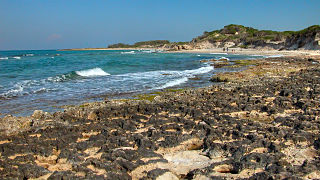
Carovigno is a town and comune in the province of Brindisi and region of Apulia, in southern Italy. The town of Carovigno has a population of 17,000 residents. Though it is small, it provides a wide array of sites and services that characterize the local life of the town. Being located in upper Salento, Carovigno is renowned for its production of high quality olive oil. Additionally, the city offers several local opportunities for tourists, including its close proximity to the sea, the beautiful landscapes of Apulia, and the cultural depth of Salento.
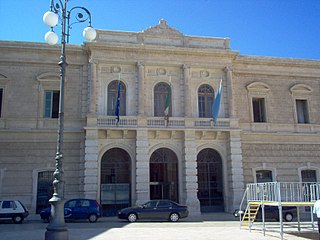
Fasano is a town and comune in the Province of Brindisi, Apulia, southern Italy. It is the second most populated town in the province after Brindisi, with a population in 2021 of 39,026.
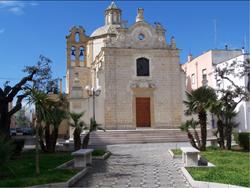
San Pietro Vernotico is a town and comune in the province of Brindisi, Apulia, on the south-east coast of Italy. Its main economic activities are tourism and the growing of olives and grapes. It was the site of a substantial Messapian community c. 500 BC.
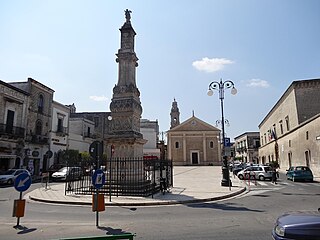
Sava is a town and comune in the province of Taranto, Apulia, southeast Italy. With its 19000 inhabitants, is one of the biggest town in the province.
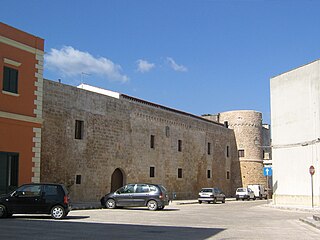
Acquarica del Capo was a town and comune in the province of Lecce, Apulia, south-eastern Italy. In 2019 it was merged with the adjacent Presicce to form Presicce-Acquarica.
San Vito dei Normanni Air Station was a United States Air Force facility located 7 miles (11 km) west of Brindisi, Apulia, between the port of Brindisi and the town of San Vito dei Normanni, Italy.

Ostuni is a white or rosé style Italian wine awarded Denominazione di Origine Controllata (DOC) status in 1972, in the Province of Brindisi of Apulia. The zone of production of the area is limited to the communes of Ostuni, Carovigno, San Vito dei Normanni, San Michele Salentino and parts of the communes of Brindisi, Latiano and Ceglie Messapica.
Specchiolla is an Italian resort on the Adriatic sea. It is a "frazione" of the city of Carovigno and near the city of San Vito dei Normanni, located it the southern part of the region of Apulia, in the province of Brindisi.
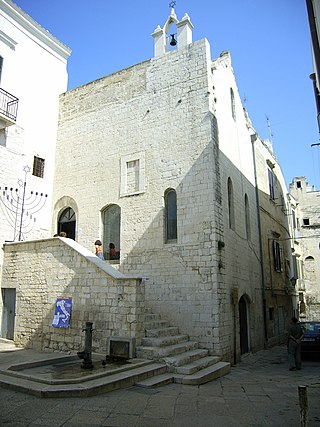
The history of the Jews in Apulia can be traced back over two thousand years. Apulia in Hebrew:פוליה) is a region in the "heel of the boot" of the peninsula of Italy bordering the Adriatic Sea. The Jews have had a presence in Apulia for at least 2000 years. The Jews of Apulia had a rich Rabbinic tradition and also had a sizeable Jewish population in the central Mediterranean prior to their expulsion.

The Terra di Otranto, or Terra d’Otranto, is an historical and geographical region of Apulia, largely corresponding to the Salento peninsula, anciently part of the Kingdom of Sicily and later of the Kingdom of Naples, which became a province of the Kingdom of the Two Sicilies.
San Vito dei Normanni is a closed railway station near the Italian town of San Vito dei Normanni, in the Province of Brindisi, Apulia. The station lies on the Adriatic Railway (Ancona–Lecce) and was opened on date 29 April 1865. The train services not stop are operated by Trenitalia.
Banca Popolare Pugliese S.C.p.A. (BPP) is an Italian cooperative bank based in Parabita and Matino, in the Province of Lecce, Apulia region.




























